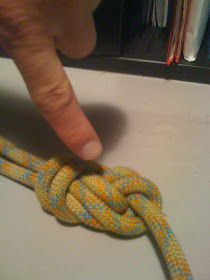This short video shows one how to tie the figure-eight follow-through. The climber in this video does a great job of dressing the knot. In other words she doesn't have any weird crosses and the knot looks very clean. What she does a poor job with is her "back-up" knot. If you use one, it should be a single fisherman's knot which is also known as a barrel knot.
This second video shows the proper finish, but names it improperly. They call it a double fisherman's knot in this video, when it is actually a single Fisherman's Knot.
The reality of the so-called "back-up knot" is that it is not necessary. If your knot is dressed and there is at least one fist worth of rope sticking out of the end of the knot, then all will be well.
Many of my students tell me that after they related this information about back-up knots to the manager of their climbing gym, the manager wouldn't relent on his gym's back-up knot policy. This is not something to sweat over. If your gym requires that you tie such a knot, you should just do it. Some gyms have insurance policies that require this unnecessary step, whereas others have created protocol based systems that are hard to change without chopping through a lot of red tape. It is less of a headache if you just follow the gym's rules while you are there.
Some climbers like to finish their figure-eight with a "Yosemite tuck" or "Yosemite finish." This is common technique is accomplished by tucking the end of the rope back into the knot. The upside of this is that it can clean up the knot. The downside is that this technique may seriously weaken the knot if you use the inside of the knot as a belay loop. If you load the loop of the knot it is possible that it will invert, after which you will only have part of the figure-eight remaining. Some people cure this problem by passing the rope around itself before going through the hole, but that makes the knot a little bigger.
And lastly, this is a nice video that shows an overview of a few different figure-eight knots from the figure-eight family:
--Jason D. Martin


Thanks so much for this post... very helpful!
ReplyDeleteI've had more and more climbing partners switching to some type of follow-through backup on figure 8s in the last couple of years. I've found each partner who does so to have the "right" way and everyone else's is "wrong."
Because of that kind of inconsistency among my competent climbing partners, I've avoided the follow-through backup myself, and ask partners to double check their knots in addition to my check.
When I have used a follow-through backup, I've tied the Figure-Eight Follow-Through with an
extra wrap as shown in the photo, but a majority of partners using a follow-through backup have disagreed with me about the tracing of the follow through, arguing that the follow through should travel in the opposite direction (in your photo, it's shown going clockwise around the rope; my partners have argued (for some reason I don't understand) that it should go counterclockwise around the rope in the setup you have pictured, before being tucked through the 8).
Any thoughts on the direction of the wrap, when not using the loop as a belay loop?
I would prefer to not see people clip inside the knot to use the loop as a belay. It's probably better to make a little loop with a piece of heavy cordage and tie it off with a double-fisherman's knot.
ReplyDelete...Or even better, get a harness with a belay loop.
Jason
I'm certainly not an expert, but I would think it could be a bit short sighted to discount alpine style harnesses based on any incompatibility with this particular tie off. A primary benefit of the tie off is it enables you to untie a heavily loaded knot, which should not happen all that often in alpine climbing.
ReplyDeletePersonally I'm used to my sport climbing harness with belay loop, but it is difficult not appreciate that the alpine harnesses allow you to put on your harness easily over clothing, crampons etc and this is a significant benefit in certain situations.